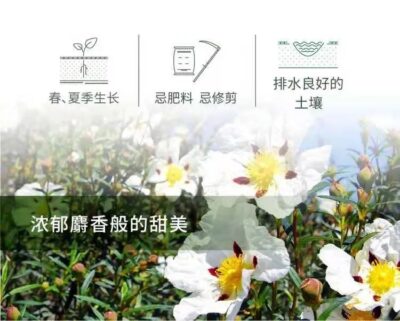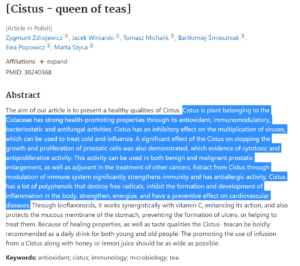
Cistus
Cistus ladaniferus
【Overview】
Key Origin|Spain
Botanical Family|Cistaceae
Aroma|Deep and distinctive woody scent with a hint of musk.
Extraction Part|Leaves
Extraction Method|Distillation

Preferred sources are from the Andalusia region in southern Spain, located on the Mediterranean coast, bordered by the Atlantic Ocean to the west, and facing Morocco to the south. This region experiences hot and dry summers, making it ideal for plant growth. Cistus is native to Spain and is also cultivated in Portugal, France, Sicily, Greece (Crete), Algeria, Morocco, and Cyprus. Wild cistus plants are increasingly discovered throughout the Mediterranean region. They thrive in well-drained sandy soil. The intense Mediterranean summer sun and drought, combined with harsh cold from the north in winter, contribute to the cistus's robust self-healing abilities. Its abundant aromatic resin easily heals broken branches and leaves. The essential oil obtained through resin distillation has the power to soothe past traumas embedded deep within the soul and skin.
➢ Essential Oil V.S. Absolute

【Key Benefits】
◇ Main Components|Monoterpenes, Monoterpenols, Diterpenols (Labdanol)
The main constituents include α-pinene (up to 55% content), camphene, bornyl acetate, ledol, hinokitiol, sabinene, and many others.
Cistus possesses strong health-supporting properties by combating natural oxidation, regulating environmental defense, and inhibiting microbial activity. It has regulatory effects on pathogen proliferation, protecting the respiratory system, and can be used during flu periods. It has also demonstrated significant effects in inhibiting the growth and proliferation of prostate cells, showcasing its cytotoxic and anti-proliferative activities, which can be applied to benign and malignant prostate enlargement as well as other cancer treatments. Extracts derived from cistus significantly enhance the body's defense mechanisms and possess the ability to regulate sensitive skin. cistus contains numerous polyphenols that can neutralize free radicals, regulate the formation and progression of inflammation within the body, and strengthen cardiovascular health.

【Component Analysis】
1. α-Pinene

α-Pinene is one of the widely distributed terpenes in nature.
It can reduce proinflammatory cytokines, regulate the excessive expression of inflammatory factors, and thus have anti-inflammatory and pain-relieving effects, helping in the healing of damaged tissues.
• Benefits: Regulates inflammation, has the ability to regulate sensitive skin.
• Application: In the chemical industry, α-pinene is catalytically oxidized to produce various artificial fragrances, such as camphorone.

(Reference: U. Neuenschwander, Mechanism of the Aerobic Oxidation of α-Pinene, ChemSusChem. 2010, 3 (1): pp. 75–84)
2. Camphene

• Benefits: Reduces respiratory mucus secretion.
• Application: Used in the preparation of fragrances or as a food flavoring additive.
3. Bomyl acetate (also known as Borneol Acetate)

It can be isolated from essential oils or synthesized by acetylation of levorotatory borneol with acetic anhydride.
- Benefits: Reduces pro-inflammatory cytokines, helps relieve stress, aids in sleep.
- Application: Used in the formulation of perfumes.
4. Himbaccol

• Benefits: Exhibits anti-tuberculosis activity, regulates inflammation, and possesses antioxidative properties.
【Market Applications】
◇ Usage/Characteristics
• • Clears the respiratory system and helps reduce mucus.
• Aids in wound healing and the recovery of new and old wounds.
• Softens the skin, protects and smooths wrinkles, soothes sensitive skin.
• Alleviates anxiety, stabilizes the nerves, nourishes.
1. Skincare Products
Benefits: Cleansing, softens the skin, balances the complexion, soothes inflammation, regulates and purifies the skin, protects the skin, smooths wrinkles.
Examples: Facial soaps, cleansing mousses, toners, serums, lotions, skin-balancing fluids, creams, eye creams, etc.
2. Body Care Products
Benefits: Antimicrobial, soothes inflammation and itching, relieves discomfort of the skin, alleviates anxiety.
Examples: Shampoos, body washes, bath products, soothing lotions.
3. Daily Necessities Products
Benefits: Clears the respiratory system, helps reduce mucus, aids in wound healing, heals new and old wounds, relieves gout, rheumatoid arthritis, muscle or joint pain, calms anxiety, stabilizes the nerves, nourishes.
Examples: Nasal sprays, soothing massage oils, ointments, perfumes, etc.
4. Household Cleaning Products
Benefits: Inhibits microbial growth, purifies the air.
Examples: Purifying sprays, cleansing hand soaps.
【Product Information】
◇ Formulation/Application
• Solubility: Lipophilic (oil-soluble).
• Mixing method:
Add at room temperature, no additional heating required, avoiding prolonged high temperatures.
Add the oil component before emulsification in cosmetics, dissolve, and mix before emulsification.
◇ Precautions
• Adjust usage proportions according to individual skin condition.
• This product is a raw material, it is recommended to dilute before use.
• Perform a patch test on a small area of the skin before applying to the face.
• Use in normal doses.
References|
1.Zygmunt Zdrojewicz et al. [Cistus - queenof teas] Pol Merkur Lekarski. 2018. Aug 29;45(266):53-56.
2.El Kabbaoui M, Chda A, El-Akhal J, Azdad O,Mejrhit N, Aarab L, Bencheikh R, Tazi A. Acute and sub-chronic toxicity studiesof the aqueous extract from leaves of Cistus ladaniferus L. inmice and rats. J Ethnopharmacol. 2017 Sep 14;209:147-156.
3.Guinoiseau E, et al. Susceptibility of themulti-drug resistant strain of Enterobacter aerogenes EA289 to the terpenealcohols from Cistus ladaniferus essential oil. Nat Prod Commun.2011 Aug;6(8):1159-62.
4.U. Neuenschwander, Mechanism of the AerobicOxidation of α-Pinene, ChemSusChem. 2010, 3 (1): pp. 75–84
5.Amensour M, Sendra E, Pérez-Alvarez JA,Skali-Senhaji N, Abrini J, Fernández-López J. Antioxidant activity and chemicalcontent of methanol and ethanol extracts from leaves of rockrose (Cistus ladaniferus).Plant Foods Hum Nutr. 2010 Jun;65(2):170-8.
6.Belmokhtar M, et al. Antihypertensive andendothelium-dependent vasodilator effects of aqueous extractof Cistus ladaniferus. Biochem Biophys Res Commun. 2009 Nov6;389(1):145-9.
7.Aziz M, et al. Relaxant effect of aqueousextract of Cistus ladaniferus on rodent intestinal contractions.Fitoterapia. 2006 Sep;77(6):425-8.
8.Regulatory mechanism of food factors in bonemetabolism and prevention of osteoporosis.Yamaguchi M. Yakugaku Zasshi.2006 Nov;126(11):1117-37.
9.Nagai T, et al. Antioxidative ability in alinoleic acid oxidation system and scavenging abilities against active oxygenspecies of enzymatic hydrolysates from pollen Cistus ladaniferus. IntJ Mol Med. 2005 Feb;15(2):259-63.
10.Mekhfi H, et al. Platelet anti-aggregant property of some Moroccanmedicinal plants. J Ethnopharmacol. 2004 Oct;94(2-3):317-22.
11[Contribution to the study of the essenceof Cistus ladaniferus]. Buenadicha P. Farmacognosia.1964;24(3):85-104.
|Some images sourced from the internet. Contact for copyright removal.|
